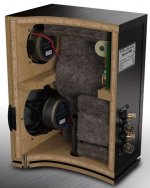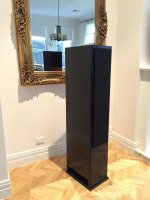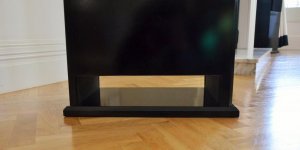Has anyone tried down firing ports on bookshelf speakers?
It would seem to eliminate the problems with rear ports being too close to the wall and if the tube is long enough, it would be up behind the tweeter.
In these Wharfedale Diamond 220 speakers, I am wondering about the size of the gap the bass is coming out of. Isn't the small size going to provide resistance and therefore the port is not a "normal" port size/length?

If I you were to use a 2" diameter downfiring port, how much space would there need to be between the port the the bottom base/platform?
It would seem to eliminate the problems with rear ports being too close to the wall and if the tube is long enough, it would be up behind the tweeter.
In these Wharfedale Diamond 220 speakers, I am wondering about the size of the gap the bass is coming out of. Isn't the small size going to provide resistance and therefore the port is not a "normal" port size/length?

If I you were to use a 2" diameter downfiring port, how much space would there need to be between the port the the bottom base/platform?
Only proac, Wilson benesch and chario comes to mind, and it should work good if one can secure a constant clearence for the port
You can simulate the effects of a port like this in Hornresp. Hint: the part under the speaker should be viewed as a short expansion between the two (effectively) curved surfaces.
Chris
Chris
Has anyone tried down firing ports on bookshelf speakers?
It would seem to eliminate the problems with rear ports being too close to the wall and if the tube is long enough, it would be up behind the tweeter.
In these Wharfedale Diamond 220 speakers, I am wondering about the size of the gap the bass is coming out of. Isn't the small size going to provide resistance and therefore the port is not a "normal" port size/length?
View attachment 927127
If I you were to use a 2" diameter downfiring port, how much space would there need to be between the port the the bottom base/platform?
You are right, the thin slot between the base and the bottom of the speaker is part of the BR-port and should be calculated as such. Its like this for most/all speakers with a downfiring port. If you have a base, its easier to calculate in case the speaker ends up on a soft floorcarpet and the port gets "smaller" when the speaker sinks in the carpet.
Such that chuffing does not occur. Chuffing occurs when the cross sectional area that the airflow sees is pinched. A 2" port has a cross sectional area of 3.1 sq. inches. Then a height of 0.5 inches will do. The circumference of the port is 6.3 inches, so a space of 0.5 inches high will keep the area at 3.1 sq. inches.If I you were to use a 2" diameter downfiring port, how much space would there need to be between the port the the bottom base/platform?
A smaller distance is possible but then it makes no sense to use a large diameter port.
If using a flared port, the circumference is larger and therefore a smaller space can be used.
Last edited:
I have a set of those Wharfedales, and FYI, the closer you get to the wall, the more bass you get. I am not sure you completely get away from wall effects with the slot port like you are thinking, you just get different effects.
-Geoff
-Geoff
- Home
- Loudspeakers
- Multi-Way
- Downfiring bookshelf ports? Anyone done one?

